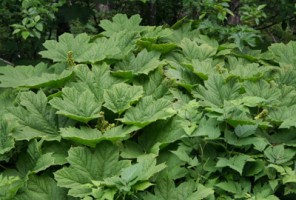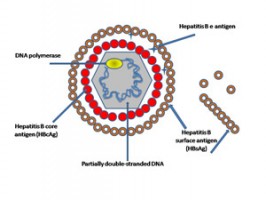Two UAA scientists pitching for NIH western region research dollars
by Kathleen McCoy |
What chemical compound in devil's club soothes inflammation? Are Alaskans who were vaccinated against highly infectious Hepatitis B 30 years ago still immune?
Those are a couple of the questions two UAA researchers hope to explore if they win funding from an innovative new national grant program aimed at increasing health research in western states.
Called the Mountain West Consortium for Clinical and Translational Science, it has 13 partners, including UAA and UAF, the medical school at the University of Nevada, universities in Hawaii, Idaho, Montana, New Mexico and Wyoming. Funded by the National Institutes for Health (NIH) for a total of $20 million over five years, the project award is called the IDeA Clinical and Translational Research Infrastructure Network (IDeA CTR-IN).
The reason behind the consortium is this reality: western states, because of their complicated rural and urban dynamics, have been less successful in attracting federal grants for research than more established institutions around the U.S.
This consortium hopes to remedy that. Scientists from partner institutions get significant benefits: database capacity through the University of New Mexico, and mentoring for young scientists through the University of Hawaii at Manoa.
Translational science means the work must improve human health and well being. Working at an institution that belongs to the consortium is no guarantee of money, however, says UAA's representative, molecular biologist Jocelyn Krebs. The dollars will be highly competitive; for the first round of funding in December, interested scientists across seven states have filed 90 letters of intent for just a handful of awards.

This image of Devil's Club comes from Gut' Shu Wu Inc., a Southeast Alaska website about medicinal plants and their uses.
What's in devil's club?
The two UAA researchers are Colin McGill, a chemistry professor, and Brenna Simons, an immunologist from the Alaska Native Tribal Health Consortium (ANTHC) who also does research at UAA. Both are early in their careers, the sort of scientists funding agencies call "junior investigators."
McGill was born and raised in Fairbanks and earned his Ph.D. in biochemistry and molecular biology from UAF. He's been at UAA for three years. His research focuses on figuring out chemical compounds in medicinal plants and how they work. Already he's knee-deep in blueberries, trying to figure out if one of their compounds really improves memory and staves off dementia.
But his newest interest is the prickly weed called devil's club.
He got started on devil's club after he heard from a friend that his mother used a salve made from devil's club to treat her arthritis. The practice is widespread among Alaska Natives and Native Americans from Alaska to British Columbia to the Pacific Northwest. With this much attention, McGill wondered, could there be something of real value in the plant extract?
Some early work at UAA proved promising enough that McGill decided to send some plant extracts to a former Fairbanks colleague, Brian Barth, now researching leukemia at Penn State. Barth's work showed that an extract of devil's club could limit the spread of inflammation.
Then Barth and his team tried applying the extract to mice with aggressive leukemia. Surprisingly, they realized a significant life extension for the males, although not the females.
Inflammation is a forerunner of many diseases, McGill said. "Anytime we can knock it down, that's significant." The fact that females didn't respond is also significant, he said. Estrogen is implicated in so many cancers that McGill expects understanding the mechanism of how devil's club works will offer insight there, too.
Funding decisions will be announced in December. If McGill's application is successful, his goal is to validate, biochemically, devil's club's widespread therapeutic use among Alaska Native people for arthritis.
Hepatitis B nightmare
While McGill is taking basic science into the clinical realm, Brenna Simons is going the other direction. She's taking historical blood samples back to the science bench to see if she can find different markers indicating successful immunization, even when antibodies are no longer present.
Simons' family moved to Alaska when she was six months old, and she stayed through early schooling at Campbell Creek Elementary (she still has her science fair ribbons from back then). But work took the family to Ohio and Simons eventually earned a doctorate from Vanderbilt University. When a job opened up at ANTHC that matched her credentials, she was eager to return to Alaska.
She works with Brian McMahon, a medical doctor who directs the Liver Disease and Hepatitis Program at the Alaska Native Medical Center. Thanks to his work, she has 30 years of data on Alaskans first vaccinated against hepatitis B in the 1980s.
Hepatitis B is an infectious inflammatory illness of the liver. It can cause cancer. Alaska has five strains of Hep B, while most other states only have two. The situation was so dire in the late 1970s and early '80s in Alaska that Simons said clinicians saw 16-year-olds who already had liver cancer.
McMahon pioneered a vaccine to stem the spread of Hep B. The good news is the vaccine worked. Acute cases have dropped to nearly zero.
But 30 years out from a vaccination means immune systems may have changed. Can the vaccinated public, and even more specifically the health care workforce, still be considered safe from Hep B?
Research shows that many have little or no sign of antibodies in their blood, yet when boosted, have a very successful antibody reaction. That suggests they are still safe.
The Centers for Disease Control and Prevention (CDC) want to know for sure. So for her work, Simons is hoping to identify other markers in the blood that indicate immunization is still effective. If successful, her findings could foreclose the need to pull patients back for costly re-immunization.
ALSO: Devil's Club: A Medicine Cabinet for Alaska Tribe (NPR report by Ketzel Levine)
NOTE: A version of this story appeared in the Anchorage Daily News on Sunday, Nov. 17, 2013.
 "Two UAA scientists pitching for NIH western region research dollars" is licensed under a Creative Commons Attribution-NonCommercial 4.0 International License.
"Two UAA scientists pitching for NIH western region research dollars" is licensed under a Creative Commons Attribution-NonCommercial 4.0 International License.















